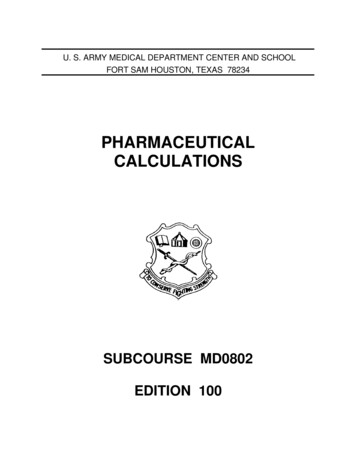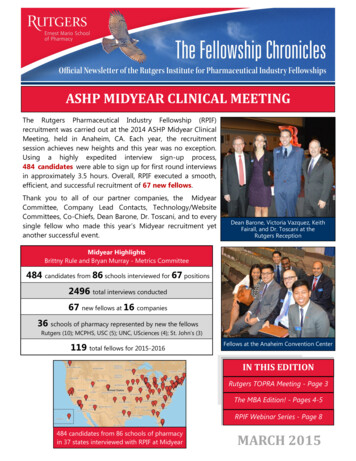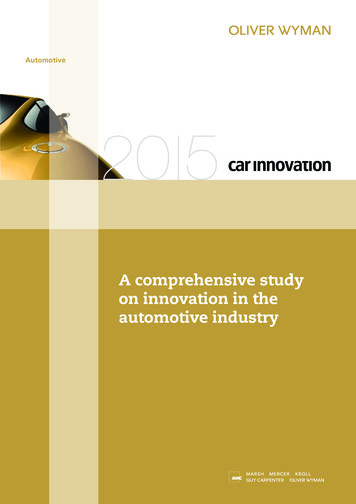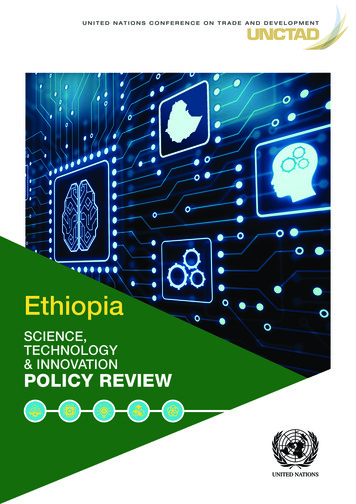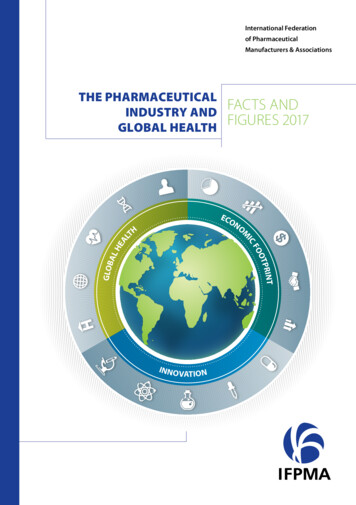
Transcription
Open Innovation in Pharmaceutical Industry: Acase study of Eli LillyBorja Hernandez RajaPriyadarsiniSambandanMaster of Science ThesisStockholm, Sweden 2015
Open Innovation in Pharmaceutical Industry: A case studyof Eli LillyBorja Hernandez RajaPriyadarsini SambandanMaster of Science Thesis INDEK 2015KTH School of Industrial Engineering and Management (ITM)Department of Industrial Economics and ManagementSE-100 44 STOCKHOLM
Master of Science Thesis INDEK 2015Open Innovation in Pharmaceutical Industry: Acase study of Eli LillyBorja Hernandez RajaPriyadarsini rrence BrownMr.Serdar TemizThesis NumberCommissionerContact person2015-47AbstractOpen Innovation paradigm has been a phenomenon of increasing interest in the lasttwo decades, especially since Henry Chesbrough coined this term in 2003, triggeringthe creation of a new whole body of knowledge. However, all this research work couldnot come up with a standardized, all-in-one theory. Instead, we find a heterogeneousseries of models that cope with different aspects and fit into specific contexts andindustries. Among these empirical experiences of Open Innovation, we find thepharmaceutical industry. The shift to Open Innovation in this industry presents severalparticularities, like the need to overcome the current productivity crisis as driver forchange, or the R&D-intensive nature of the industry. In this scenario of urgency, the lackof a well-established theoretical model on Open Innovation makes difficult the task ofimplementing this paradigm.In this research work, we explore in detail the process of adoption of Open Innovation inthe pharmaceutical industry through a case study, and analyze the empirical findings byframing it inside the current theoretical framework. Through this analysis, we aim tohighlight generalizable patterns, and specific elements from the current body ofknowledge. These highlights might serve as input for the creation of a unified model ofOpen Innovation.Keywords: Open Innovation, Pharmaceutical Industry, Drug Discovery, Big Pharma,Crowdsourcing, Open Source drug discovery.
Open innovation in pharmaceutical industry- A case study of Eli lillyAcknowledgementWe would like to express our sincere gratitude towards everyone who helped us in thecompletion of our thesis. Thanks to our supervisor, Serdar Temiz, who supported usthroughout with his valuable suggestions and comments. It indeed encouraged us towork harder. Special thanks to our programme director, Dr.Terrence Brown for gettingus in touch with Francesca Bignami, a PhD student at Karolinska Institute who is alsoworking on a similar subject. She provided us with some valuable insights. We wouldalso like to thank Professor Staffan Laestadius for giving us some direction at thebeginning of our thesis. Last but not the least we would like to thank all our friends andfamily for their unconditional support.Borja Hernandez RajaPriyadarsini Sambandan
Open innovation in pharmaceutical industry- A case study of Eli lillyList of AbbreviationCROContract Research OrganizationCSRCorporate Social ResponsibilityFIPCoFully Integrated Pharmaceutical CompanyFIPNetFully Integrated Pharmaceutical NetworkIMIInnovative Medicines InitiativeIPIntellectual PropertyL2POCLean To Proof Of ConceptM&AMerger and AcquisitionMDRTB-Multidrug-resistant TuberculosisNMENew Molecular EntityNCENew Chemical EntityNBENew Biotech EntityOIOpen InnovationPD2Phenotypic Drug DiscoveryPOCProof Of ConceptPOSProbability Of Success of drug development processPPPPublic Private Partnershipp(TS)Probability of Technical SuccessR&DResearch & DevelopmentSDKSoftware Development KitSMESmall-Medium EnterpriseTBDATuberculosis Drug AcceleratorTBDDITuberculosis Drug Discovery InitiativeTD2Target Drug DiscoveryTSSTechnical and Scientific ServicesWHOWorld Health OrganizationWIPWork In ProgressBorja Hernandez RajaPriyadarsini Sambandan
Open innovation in pharmaceutical industry- A case study of Eli lillyTable of Content1.INTRODUCTION . 1.4.5.2.4.5.3.4.5.4.4.5.65.RESEARCH QUESTION . 2SCOPE . 2OUTLINE . 2LITERATURE REVIEW . 3OPEN INNOVATION . 3Practices in OI . 4Models of OI . 6Benefits of OI . 8PHARMACEUTICAL INDUSTRY . 9Value chain of the industry &definition . 10Current situation of Crisis . 12Consequences of the crisis . 13EXISTING FRAMEWORK OF OI IN THE BIG PHARMAS . 16Degree of Externalization . 16Structural Perspective of Open Innovation. 17METHODOLOGY. 21RESEARCH PARADIGM . 21RESEARCH DESIGN . 21DATA COLLECTION . 22Sample case study . 22LIMITATION . 22DELIMITATION . 22CASE STUDY . 24HISTORY . 24CRISIS. 25STRATEGY . 25OI INITIATIVES BY ELI LILLY . 27Chorus . 27Innocentive . 28TBDDI . 29Open innovation drug discovery program . 30DISCUSSION. 31Strategy – FIPNet & Chorus . 31Crowdsourcing . 33Public-Private partnerships (PPP) . 34Open Source – PD2 & TD2 . 35Summary of discussion . 36CONCLUSION AND RECOMMENDATION FOR FUTURE RESEARCH . 37REFERENCES . 38Borja Hernandez RajaPriyadarsini Sambandan
Open innovation in pharmaceutical industry- A case study of Eli lillyTable of figuresFigure 1 - Close Innovation VS Open Innovation . 4Figure 2 - Decision-Making matrix . 8Figure 3 - Pharmaceutical Innovation Value chain . 10Figure 4 - R&D model yielding costs to successfully discover and develop a single NME . 11Figure 5 - Drug discovery and critical partners . 14Figure 6 - Four new types of innovation model in Pharmaceutical Industry . 16Figure 7 - FIPNet, transforming Eli Lilly’s Business Model . 26Figure 8 - The quick win, fast fail drug development paradigm . 28Figure 9 - Open Innovation assays at Lilly . 31Figure 10 - Lily external R&D initiatives . 32Figure 11 - FIPCo to FIPNet transition . 33Figure 12 – Comparison of Lilly’s OI practices . 36Borja Hernandez RajaPriyadarsini Sambandan
Open innovation in pharmaceutical industry- A case study of Eli lilly1.IntroductionPharmaceutical industry is a highly innovation driven industry which throughout itshistory has contributed to the well-being of the humans by providing new medicines toaddress various diseases and have grown into one of the major sectors in the world.The global pharmaceutical industry is currently worth US 300 billion with few drugcompanies controlling almost one third of the market (World Health Organization, 2015).These few companies termed as the “Big pharma” have been thriving in the market byinvesting in R&D and commercialization of high value “blockbuster drugs”. Apharmaceutical company can be called as a Big Pharma based upon four criteria,namely the sales per year which should be above 2 billion USD, international presencewhich includes presence in USA, Europe and Japan, involvement in several therapeuticareas with R&D and marketing in at least five different therapeutic areas and anestablishment of fully integrated pharmaceutical operations including internal R&D,manufacturing, clinical trials, regulatory, marketing and sales (Hedner, 2012).However in the past decade the industry has faced and continuing to face severalchallenges in terms of patent expiration resulting in huge revenue loss, increasing R&Dcost for new drug development, declining R&D productivity, growing competition fromgeneric drug manufacturer, changes in the marketing climate with cost-constrainedhealthcare systems and rising customer expectation for new, cheaper and moreeffective therapeutic drugs. The model of innovation which was in practice in the pastdecade where the innovative activities were predominantly carried out in-house wasclaimed to be a broken model as the sustainability of the industry was under question(FierceBiotech, 2011). The Big pharmas have been working on several strategies tocombat the challenges. Some of the major steps taken by them are by restructuringtheir innovation model. They are pursuing merger and acquisition, joint ventures,partnership, collaborative research with academia, Biotech companies, CROs and othersmaller pharmaceutical companies. In the past decade the innovation model in theindustry has evolved from an integrated one to collaborative to more open andnetworked model (Sadat et al, 2014).In the open and networked model the boundaries between all the actors along thepharmaceutical innovation value chain becomes more porous where every contact istreated as a potential part of the innovation ecosystem. Studies reveal that there hasbeen a growing trend in the industry towards Open Innovation (Khanna, 2012). SeveralBig Pharmas have also openly stated that they have or will move towards OpenInnovation (OI, from now) but where along the innovation continuum it is beingeffectively adopted and by whom is a subject of ongoing research (Michelino et al,2014) . However there have been a number of challenges with respect to the adoptionof OI like IP management, Standardization of the process, Management difficulties withrespect to virtually dispersed R&D, incentivization, lack of leadership, governance,technical do-ability, loss of architectural knowledge (Lowman et al, 2012). OI also posesa need for cultural change within the organization and alignment of the overall businessstrategy with the OI process. Firms should also rethink their business model and alsohave the ability to choose the right collaborations.The concept of OI was established recently (2003) by Henry Chesbrough and lot ofstudies have been conducted to identify its various elements in different industries.Although certain elements of OI has been in practice in the Pharmaceutical industry inBorja Hernandez RajaPriyadarsini SambandanPage 1
Open innovation in pharmaceutical industry- A case study of Eli lillyvarious forms for a long time it has not been until recently that the concept is extensivelystudied specifically to this industry and there are a lot of ongoing research to establish atheoretical framework for OI in pharmaceutical industry. The pharmaceutical industry isa complex industry which involves several actors who practice OI at different levels. Itwould be interesting to understand the phenomenon from the perspective of the BigPharmas since they are the main drivers of change in the innovation ecosystem of theindustry, leading us to the goal of this paper.1.1.Research QuestionOI seems to be gaining a steady ground and recognition in most of the industries thesedays. In particular Big pharmas, owing to the crisis in the industry, are resorting to newstrategies to keep up their growth and innovativeness with OI being one of them.Studying OI strategies of a particular Big Pharma in detail can provide valuable insightsto other companies within the industry who wants to adopt the same approach withminimum risks. Further classifying them under the general OI paradigms or practiceswill add knowledge to the existing literature on OI. Hence our research question is asfollows,How do Big Pharmas implement OI?–A Critical analysis of the current OI practicesthrough a case study.1.2.ScopeThe scope of the study is to examine some of the OI initiatives undertaken by a BigPharma called Eli Lilly (referred also as Lilly, in this document) in the recent times. Theresearch is constructed around the critical analysis and classification of the initiatives byLilly under various new OI paradigms identified. We have limited our analysis to thedrug discovery and development phase of the value chain in the Big Pharmas.1.3.OutlineWe first start with the literature review wherein we are trying to understand the conceptsof OI. We provide the definition of OI and identify the various models of OI. We then tryto understand the triggers and benefits of OI in general. We then continue our literaturereview to the pharmaceutical industry. We provide some insight on the Industry throughsome history, by explaining the current crisis in the industry and the ways adopted byBig Pharmas to combat the crisis. We then explain the importance of OI to Big Pharmasand the existing framework of OI in the pharmaceutical industry. The literature review isfollowed by the case study of a Big Pharma, Eli Lilly, and its OI practices followed by theanalysis of the case study and conclusion.Borja Hernandez RajaPriyadarsini SambandanPage 2
Open innovation in pharmaceutical industry- A case study of Eli lilly2.Literature ReviewIn this chapter, we carry out a deep review of the existing knowledge related with theresearch question in order to provide the necessary background as a departing point forour discussion.2.1.Open InnovationThe term “Open Innovation” was coined by Professor Henry Chesbrough, referring tothe need for firms to adapt to a fast-changing environment, increasing competition andspecialization of firms, among other factors. To face these challenges, OI is defined as“a paradigm that assumes that firms can and should use external ideas as well asinternal ideas, and internal and external paths to market, as the firms look to advancetheir technology” (Chesbrough, 2003). Firms achieve this by commercializing “both itsinternal ideas and external ones from other companies, and search for ways to put theirideas on the market through the development of different routes that are not a part of itsusual business” (Chesbrough, 2003). In other words, OI can be defined as “the use ofpurposive inflows and outflows of knowledge to accelerate internal innovation andexpand the markets for external use of innovation, respectively.” (Chesbrough et al.,2006). It is important to note that OI is not a strategy of working with external parties;instead, it is about leveraging internal R&D. OI encourages companies to expand theirpool of resources in order to achieve their growth objectives.Triggers for OI: As briefly said before, there is a series of factors that may havepushed companies to shift their practices to OI. They are; The growing mobility of skilled professionals; meaning staffs are no more attachedto a single company in a long term relationship and the labor market is becomingmuch more dynamic with employees changing location and roles more often(Chesbrough 2003; Gassman & Enkel 2004). This makes it difficult for a firm tomaintain its core-competencies, as the staffs leaving will take the knowledge withthem. As a result, large amount of knowledge now exists outside the boundaries ofthe firm. This fact encourages firms to open to the outside, tapping into the pool ofexternal resources to maintain competencies and acquire new ones.The rise of venture capital funding: It is incentivizing the creation and developmentof new firms and startups. It also triggers consequences like restructuration ofindustries, increases in competition, shifts in the market share, etc. (Chesbrough,2003). Specifically, these new entrants play an important role in what comes toinnovation, as they often enter the market using highly innovative, disruptiveproducts (Christensen, 2013).Faster cycles of product development, as products themselves become obsoletemuch more quickly than earlier (Harvey, 2010).Globalization of the markets, with the consequent hardening of the competition, asfirms competes in a given industry at a global scale (Harvey, 2010).Increase of specialization is more and more necessary (Gassman et al., 2010). Asthe complexity of technologies grows, firms need to focus in a narrow area tomaster their competencies. This implies that other competencies should be droppedif the firm wants to keep focus and efficiency.The increasing capability of external suppliers (Gassman & Enkel, 2004) and thethreat of competition from them.Borja Hernandez RajaPriyadarsini SambandanPage 3
Open innovation in pharmaceutical industry- A case study of Eli lillyClosed Innovation VS Open Innovation: Traditionally, firms sought for differentiationin the market by internally developing core competencies and protecting these againstleakages to the outside, in order to keep their competitive advantage. This model wasengineered by a science-driven type of innovation to feed the product developmentprocess, in an effort to continuously deliver new goods to the market to maintain itsposition in the industry (Chesbrough, 2003).Considering the contextual changes referred above, it can be inferred that thistraditional model–so-called Closed Innovation, is not performing anymore. In fact, a firmkeeping this strategy has to possess a large range of technologies and domains ofknowledge, which will result in the loss of specialization and increase of risks and effort,not to mention the resulting managerial and structural overheads. A good example ofthis model is the one carried out by Xerox in its PARC research facility (Chesbrough,2003) in the decades of 1980 & 1990. This case shows how Xerox was very successfulin developing new technologies, but then failed in later steps of the productdevelopment, because of an excessive tight corporate structure.Therefore, a different strategy is required to keep the competitive advantage, bykeeping the specialization of their core competencies, and, at the same time, tappinginto existing non-core knowledge with minimized effort, and combining the whole tomeet the ever-increasing quality standards. The figure below shows how the boundariesto incorporate external knowledge are different between closed (traditional) innovation,and OI.Figure 1-Close Innovation VS Open Innovation(Chesbrough, 2003)Hence, firms are being pushed to adopt OI in order to not become obsolete.2.1.1Practices in OITherefore, we can infer, in general lines, that OI paradigm is supported by the idea thatknowledge is not anymore proprietary to the company, but it resides in employees,suppliers, customers, competitors, policy-makers and other stakeholders. So there is aneed to make firm’s boundaries more permeable (Chesbrough, 2006) and exploit thisknowledge that leads into innovation by creating the proper mechanisms to interfacewith this external knowledge. When it comes to implement this paradigm, firms makeBorja Hernandez RajaPriyadarsini SambandanPage 4
Open innovation in pharmaceutical industry- A case study of Eli lillyuse of different mechanism to success in open the necessary linkages. These havebeen identified and analyzed by academia, resulting in the following classification ofpractices: IP: claimed to be the currency in OI (Hunter & Stephens, 2010), it implements themechanisms and restrictions for firms to exploit existing knowledge under aregulatory frame.Trading of IP allows a firm to have additional revenues from its base of knowledge,without losing control of it, and preventing an eventual appropriability of the knowhow by the competitors. But it can be also used as a strategy to create standards ortechnological paths (Teece, 2002).For the firm acquiring IP, it is a way to have quick access to non-core knowledge inorder to focus on its competencies and speed-up the product development process.IP management implies a series of complexities, ranging from the pricing to usagerestrictions (to encourage licensor to share knowledge minimizing the risk ofappropriability from competitors.Venturing: broadly speaking, a venture is an alternative way of developing aninnovation away from the established organizational structure of a consolidatedfirm. The reason for this is that established organization tends to filter out innovationout of the existing business model (Tidd et al., 2014). Venturing is a way to let theseinnovations to be developed in a more loose and dynamic environment, whileallowing the parent firm to keep focus on their activities and avoid over complicationof its structure.Venturing can take different forms: a split of a firm’s division into a more-or-lessindependent contact, with the parent company benefiting from the knowledge of thechild (spin off), or the firm’s division being sold through M&A (spin out). VentureCapital is also used by firms themselves to ensure their access to certainknowledge from smaller, more innovative actors in the same industry (Tidd et al.2014).This type of practices allows a company to spread the risk by diversifying thebusiness model, reaching new markets, etc.Collaboration & Networking: even if every OI practice is based on an exchangebetween networked actors, we refer in this section to a series of more informal,dynamic practices that enables the creation of a “virtual company” (Tidd et al. 2014)in a network that facilitates the flow of knowledge.A variety of factors define the linkages: the actors or nodes in the, the points alongthe value chain at which they operate, the purpose of the relationship, the level offlexibility (from alliances more loose to formal joint-ventures) and the duration intime. All these factors create a whole range of typical linkages (Tidd et al., 2014).In these networks we find a balance of power, where the actions of one actor canaffect other actors. Thus the place that a firm occupies in the network is of highstrategic importance (Tidd et al., 2014). It would be also important to say thatcollaboration, as happen with other OI practices, is not without risks; collaborate inan OI environment can lead to leakage of information, or loose ofownership/leadership.Perspectives of OI (Gassman & Chesbrough, 2010): Alternatively, we find anotherinteresting classification in OI practices suggested by Gassman & Chesbrough (2010)that attends not to the specific structure that the practice adopts, but to the firm’sdimension where it operates (so-called, perspective). We thus find differentperspectives into which a firm can develop new OI practices:Borja Hernandez RajaPriyadarsini SambandanPage 5
Open innovation in pharmaceutical industry- A case study of Eli lilly Spatial perspective: related with geographical location of the firm’s assets, markets,stakeholders, etc., it emphasizes the fact that firms operate in a global market.Structural perspective: refers to how an industry is structured, the value chainshared among different actors (suppliers, manufacturers, etc.) and how the firm isnetworked with these. This perspective deals with OI practices such as outsourcing,alliances, etc.User perspective: refers to any practice that aim to integrate the user within theinnovation process, to obtain accurate feedback of their needs and requirements,and considering user himself as a source of innovation.Supplier perspective: seeks for OI practices where suppliers become a source ofinnovation.Leveraging perspective: aims to maximize the benefit from existing assets throughmarketing, business model innovation. IP plays an important role here.Process perspective: focus on how the OI paradigm is perceived and managed in afirm. For example, which kind of knowledge flows (inbound or outbound) is moresignificant.Tool perspective: emphasizes the need of tools to enable OI practices. Examples ofthese tools are SDKs in software industry or Tool Kits for users to enable massCustomization.Institutional perspective: this perspective deals with the balance betweenproprietary and public knowledge and how a firm uses a combination of both.Cultural perspective: deals with the organization culture and mindset, the style ofmanagement, the corporate structure, etc., and how these factors affect theadoption of OI.2.1.2Models of OIAttending to the way a firm combines the different OI practices, and together with otherfactors (in special, the practices related with innovation management itself), academiahas tried to establish models and classifications, yet with no success in creating astandardized set of OI models.Marais & Schutte (2009); These authors provide a classification of 5 models fromanalyzing real-life examples. These models focus on maximizing the innovativeness offirms by creating linkages with users/customers in different ways: Product platforms: this approach involves developing and introducing a partiallycompleted product/base product, for the purpose of providing a framework forprosumers (customer who helps a company to design and produce its products).This model implies that the organization has a complete control over the valuechain and the scalability factor is high due to the involvement of the prosumers inthe product development which creates a "network effect".Idea competitions: this model entails implementing a system that encouragescompetitiveness among contributors by rewarding successful submissions. Theprimary offering of idea competition thus focuses on gaining a large quantity ofinexpensive ideas, while also gaining insight into the customer's needs and wants.Some of the criteria for this model to work are that the IP rights need to beformalized to protect the organization and the prosumer, a well-developed rewardscheme, a relatable product/Service for the prosumers, organizational capability toassess and evaluate competition entries and a well marketed competition.Borja Hernandez RajaPriyadarsini SambandanPage 6
Open innovation in pharmaceutical industry- A case study of Eli lilly Customer immersion: this technique involves extensive custome
Keywords: Open Innovation, Pharmaceutical Industry, Drug Discovery, Big Pharma, Crowdsourcing, Open Source drug discovery. Master of Science Thesis INDEK 2015 Open Innovation in Pharmaceutical Industry: A case study of Eli Lilly Borja Hernandez Raja Priyadarsini Sambandan Approved 2015 -05-26 Examiner Dr.Terrence Brown Supervisor
